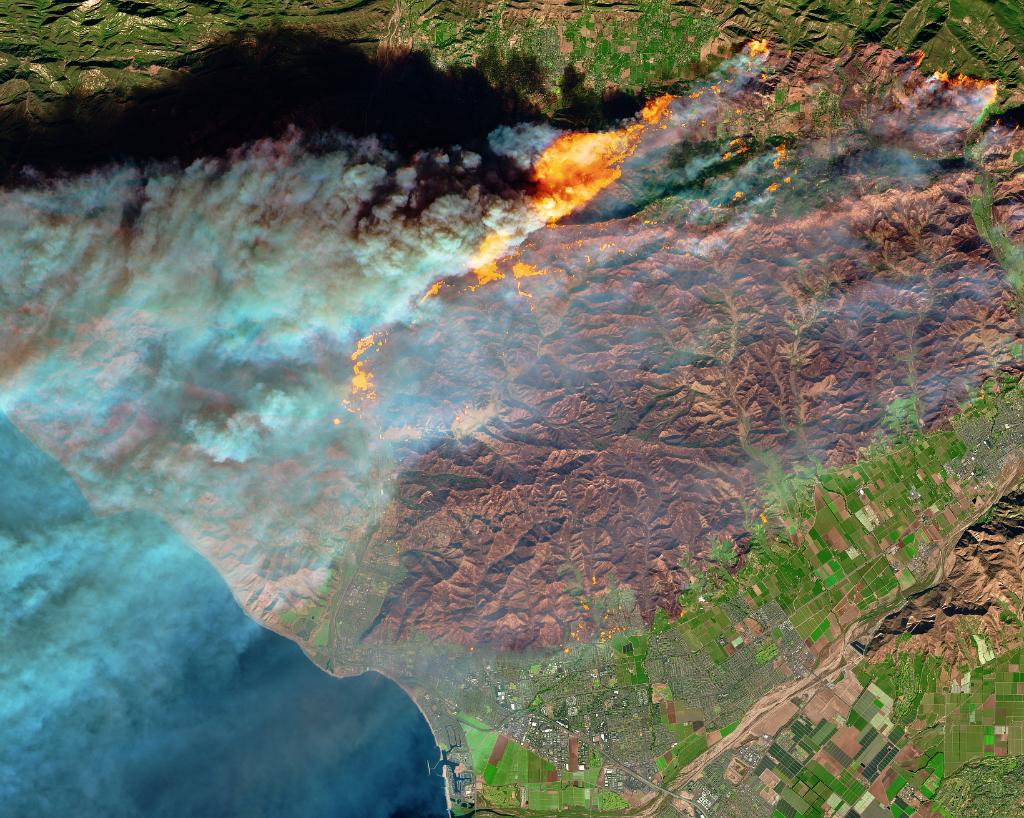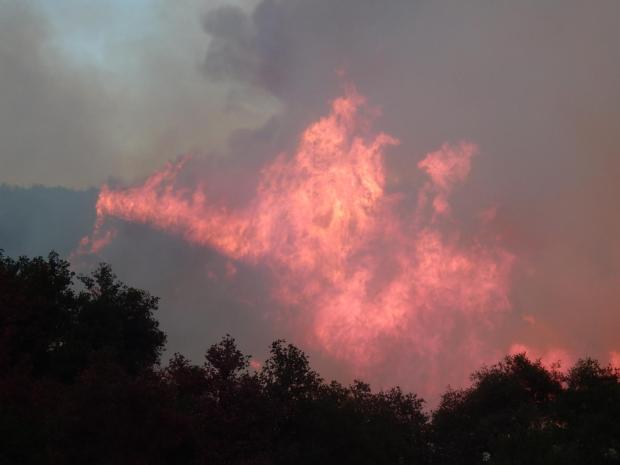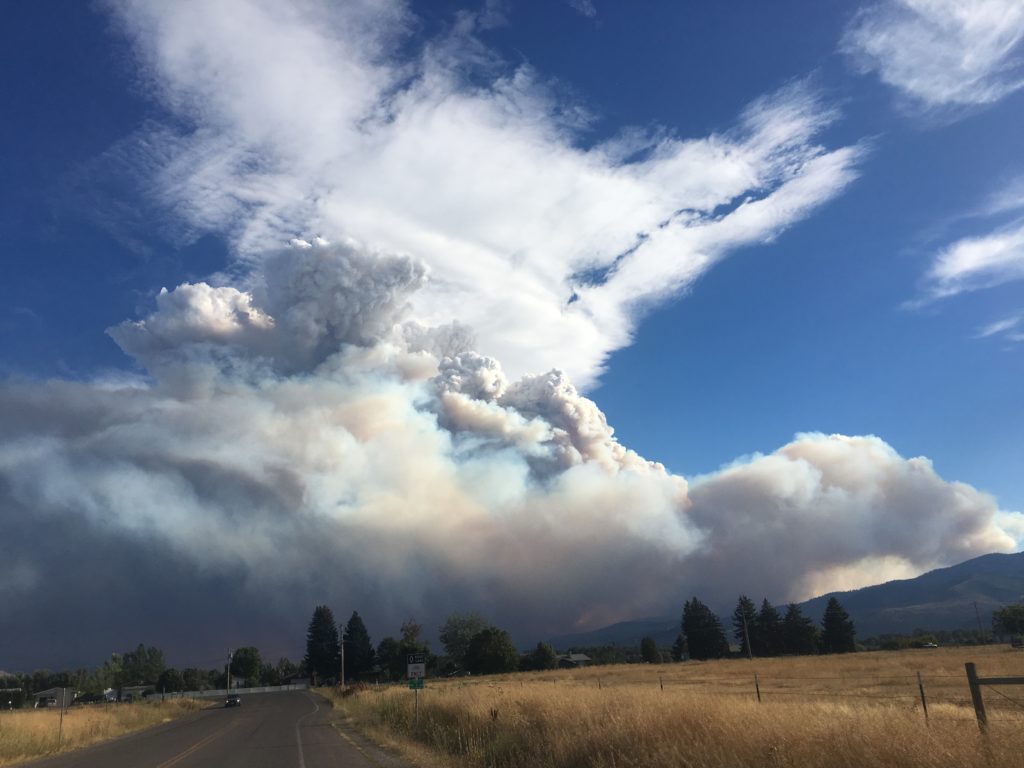Former Forest Service chiefs to Congress: Wildfire funding needs immediate fix
Posted: February 8, 2018Source: Treesource

Burn scars and active fires in Ventura County, California, are visible in this false-color view created using data from @ESA’s Sentinel-2 satellite on Dec. 5. Active fires appear orange, while burn scars are brown. Photo:NASA
Six former chiefs of the Forest Service have written leaders of the U.S. House and Senate expressing the urgent need to establish a new method of funding wildland firefighting.
The Forest Service and Department of Interior, they said, are alone among federal agencies in being forced to finance catastrophic emergency operations – fighting wildfires – out of their regular operational budgets.
“Today the Forest Service spends over half of its budget on fire management activities, compared to 16 percent in 1995,” the chiefs wrote. “In a 2015 report, the Forest Service projected the fire budget would consume two-thirds of the agency’s budget by 2025.”
And here’s the rub: The more wildland firefighting consumes the Forest Service’s budget, the less money the agency has for management activities that would either lessen the fire danger or make it easier to control fires once they start.
Thus the need for an immediate fire funding fix, said former chiefs Max Peterson, Dale Robertson, Michael Dombeck, Dale Bosworth, Abigail Kimball and Thomas Tidwell.
“In the last two decades, the number of national forest employees has dropped from 19,000 to 11,000, while the number of firefighters has more than doubled,” they said. “This is crippling the agency’s efforts to increase critical management activities.
“For these reasons, we ask you to pass a comprehensive fire funding fix. We cannot waste this rare opportunity.”

The Thomas fire in and around Ventura, California, burned about 282,000 acres in late 2017. Photo:InciWeb
The memory of 2017’s wildland fire calamities are fresh, the numbers daunting: 58,000 wildfires; 9.3 million acres of federal, state, tribal and private lands burned; another 80 million acres and 70,000 communities at risk of catastrophic fire.
“Our nation’s forests are in crisis,” the chiefs wrote the House and Senate majority and minority leaders. “It is clear, the trend of more and larger catastrophic fires is going to continue indefinitely unless and until we get much more aggressive at managing our forests, using all available tools such as prescribed fire, timber harvesting, managed natural wildfires and pre-commercial thinning.”
According to the chiefs, science and research show that 90 percent of the preventive fuel treatments are effective in either modifying a wildfire’s behavior or helping firefighters to control the fire.
But all of the treatments require money and employees the Forest Service no longer has. (In fact, the number of national forest employees has decreased from 19,000 to 11,000 in the past two decades.)
The retired chiefs are not alone in calling for a new wildfire-funding method. The National Governors Association, Western Governors Association, the National Association of State Foresters and more than 200 conservation, timber, wildlife, recreation and sportsmen’s organizations have asked Congress to do the same.
A number of Western congressmen and women have proposed legislative fixes as well, but the measures have not yet met with favor from the House or Senate.
In the last session of Congress, Rep. Mike Simpson of Idaho introduced the Wildfire Disaster Funding Act along with 150 cosponsors.
“Many Idahoans, including myself, have called for better management of our forests, but until we reform the way we budget for wildfires, none of the actions we advocate — including thinning, timber harvesting, and active management — can consistently take place,” Simpson said in introducing the bill.
H.R. 2862 would end so-called “fire borrowing” and “ensure that the way we budget for fires makes sense,” Simpson said.
The measure continues to await congressional action.

Heat, low humidity and high winds sent the Lolo Peak fire on a spectacular run late on Aug. 18, filling the sky to the south of Missoula, Montana. Photo: KellyHenkel
Here is the full text of the chiefs’ letter:
Dear Speaker Ryan, Minority Leader Pelosi, Majority Leader McConnell and Minority Leader Schumer:
As the lost homes and lives from last year’s wildfires sadly reminded us, we are experiencing longer, hotter and more devastating fire seasons. This past fire season registered as the costliest in history, with over 58,000 wildfires on 9.3 million acres of federal, state, tribal and private lands. This was not an anomaly. Our nation’s forests are in crisis. On the national forests, current data is showing that around 80 million acres are at high risk of catastrophic fire with potential impacts to over 70,000 communities. The unprecedented levels of insect and disease epidemics, combined with extended drought and climate change have caused tree mortality at the highest levels in recorded history. In California alone in the last few years, we’ve lost over 100 million trees. So it is clear, the trend of more and larger catastrophic fires is going to continue indefinitely unless and until we get much more aggressive at managing our forests, using all available tools such as prescribed fire, timber harvesting, managed natural wildfires and pre-commercial thinning. Research and science have demonstrated that 90% of preventive fuel treatments are effective in changing the fire behavior and/or helping with control of the wildfire. We simply need to do more proactive forest management.
Unfortunately, the ability of the Forest Service to ramp up preventative forest treatments on national forests, and to assist states with their forest health management, is being impacted by the increasing cost of firefighting and the archaic 10-year average method being used to fund fire suppression. The Department of the Interior and to a much greater degree the Forest Service are the only government entities required to pay for catastrophic emergency operations out of their regular appropriated budgets. Today the Forest Service spends over half of its budget on fire management activities, compared to 16% in 1995. In a 2015 report, the Forest Service projected the fire budget would consume two thirds of the agency’s budget by 2025. Conditions on the ground are worsening and the agency is now projecting the fire budget to consume two thirds of the overall budget four years sooner in 2021. In the last two decades, the number of national forest employees has dropped from 19,000 to 11,000, while the number of firefighters has more than doubled. This is crippling the agency’s efforts to increase critical management activities.
For these reasons, we ask you to pass a comprehensive fire funding fix. We cannot waste this rare opportunity. Active management of our nation’s forests is crucial, not only for providing jobs and prosperity to rural communities, but for providing clean water, abundant wildlife habitat, recreational opportunities and all the other amenities that come from well managed forests. The National Governors Association, Western Governors Association, the National Association of State Foresters and over 200 conservation, timber, wildlife, recreation and sportsmen’s organizations have all expressed strong support for a comprehensive fire funding fix. If not now, when? The future of our forests is in your hands.
